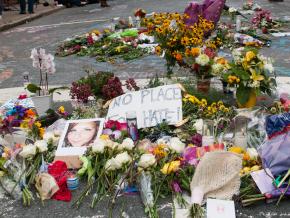Putting Heather Heyer’s murderer on trial
The white supremacist who killed Heather Heyer and injured dozens of anti-racists when he drove his car into a protest march in Charlottesville, Virginia, is on trial for murder, malicious assault and malicious wounding. James Alex Fields Jr.’s attack came at the end of the second day of the alt-right’s Unite the Right rally that became an orgy of hate, violence and intimidation.
is a survivor of the car attack — he sustained serious injuries that landed him in the hospital. You can read his reflections one year after Charlottesville in this article at SW. Bill decided to be present at Fields’ trial. He sent us this report from the courtroom as the trial was wrapping up, with closing arguments about to take place, followed by the deliberations of the jury.
I TRAVELED to Charlottesville, Virginia, to observe the trial of James Alex Fields Jr., who plowed his car into a crowd of counterprotesters I was part of on August 12, 2017, killing one of our group of marchers, Heather Heyer.
I went to the trial not sure what to expect. Fields’ defense strategy is to assert that he acted in self-defense on that horrific day — even though he chose to drive his car toward, rather than away, from the peaceful protesters he said he feared. He claimed he was scared of the people behind him, while pictures put into evidence and eyewitness testimony show nobody was near his car.

Sixteen months later, the feelings of support and solidarity in Charlottesville still run strong toward the anti-racists who mobilized against the Unite the Right rally that day. Although there have been no demonstrations outside the courthouse by either side, the Charlottesville Women’s Initiative has offered free lunches. Several clergy have stopped to offer their support, and passersby offer words of encouragement. Everywhere you look, you see purple, heart-shaped signs with Heather’s name on them.
No fascists or white supremacists have been spotted so far, but there are cops and feds in every direction. This leaves me just as nervous. I am not feeling any safer.
Fields’ defense team didn’t do much to cross-examine the victims who were called by the prosecution. And when the defense did ask questions, they focused on minor issues, like the wording of testimony, or to clarify the locations being discussed.
Three people did testify on Fields’ behalf, stating that he was calm and showed no signs of fear or anger before the attack. All three were asked why they decided to attend the rally — two said it was because they were interested in hearing the speakers, and one said “to be with like-minded individuals.”
Fields spent his time trying to avoid eye contact with anyone. The most emotion that he showed was when he watched the police video of his arrest and listened to himself cry and hyperventilate when he heard he had killed someone. But even then, his reaction was confined to staring at the television and nervously fidgeting with a pencil in his fingers. I took it as a realization that his freedom is over, not any concern about Heather’s life.
The prosecution did a thorough job. When the defense made a motion to dismiss the charges once the prosecution had rested, the judge refused to grant the motion, saying that he had no doubt the jury could find intent and malice behind Fields’ actions.
The prosecution picked nine people who suffered serious injuries in the car attack to prove the “malicious wounding” charge. These nine people are still visibly suffering from some serious injuries that will require further surgeries, or they are still going through rehabilitation — not to mention the psychological wounds that many of us carry.
The prosecution said my injuries fit the malicious wounding criteria, but today, those injuries aren’t as obvious as those suffered by some of the others, and it would have taken more effort to prove them. So instead of “muddying the waters,” they opted not to give the defense any kind of opportunity or issue to grab hold of.
I didn’t press the issue because the federal hate crime trial is still to come, and the federal prosecutors said that I will be a named a victim and testify during that trial.
TENSIONS ARE still high in the courtroom. At one point during testimony, a reporter who uses a cane fell as she was leaving, making a loud noise in the back of the courtroom and provoking a collective gasp among those who saw her fall.
I immediately bolted to my feet and turned toward the noise, ready to fight. I had been wondering if the alt-right might try to disrupt this trial with violence, and I thought this might be the moment.
Another survivor of the attack, Marcus Martin — the man pictured suspended in midair in the incredible photo of the moment Fields drove his car into the crowd — was sitting beside me and did the same.
Marcus and I didn’t know what caused the commotion, but we recognized the hair-trigger fight-or-flight reflex in each other. This experience created a bond between us, and we have been inseparable since.
As Fields drove at the crowd, Marcus pushed his then-fiancé (now wife) out of the way and took the brunt of the car’s force. It’s not for me to list his injuries, but just imagine being hit so hard that you fly into the air and lose your shoes.
When I asked him what that photograph means to him when he looks at it today, he said, “I’m still very angry, disgusted that people hate me enough to do that, but also blessed and thankful for my life.”
We talk for a while about the full range of emotions that we’ve experienced over the last year, and then he tells me that I’m “one of the coolest white boys he knows.” I am humbled by his words.


